Forum Responses
(Sawing and Drying Forum)
From contributor E:
I had just started sawing in 1994 with my new Timberking 1600 when a friend wanted two cedar logs sawn. I sawed the eight foot butt cut with no problem and started the top eight foot cut which had been cut off at a fork in the tree. It looked like everything was going along fine when I was taking the second slab cut off. As the blade entered the forked area the engine suddenly died with an awful noise from the blade. After getting the toothless blade out of the cut I took a chainsaw and cut near the point where the blade stopped. After a few strokes with an axe I saw the culprit, a two piece magnet the size of a quarter 2" long had been lodged in the fork and the tree had grown around it. Still till this day I have not figured out how a magnet had made it 16' up a cedar tree!
But, they had nails then too! These are all the nails I found, one way or another. Most I was able to pull. I got lucky and found stain marks as I slabbed the timber and was able to get some nails out before the band blade hit it, but it did ruin three blades total. Those nails are the old fashion kind - they're square! It wasn't just a ruined day, it was three ruined days. That's how long it took to work those timbers. But the history behind them continues to play in my mind still.

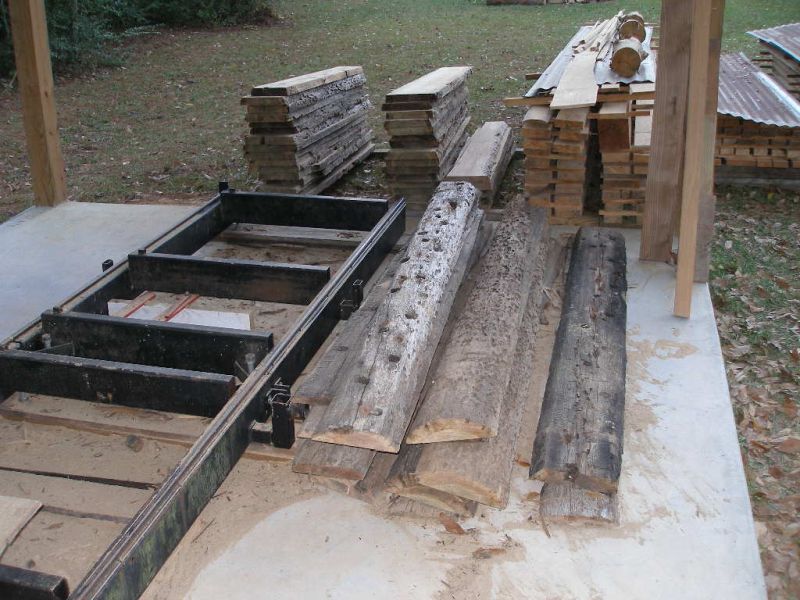

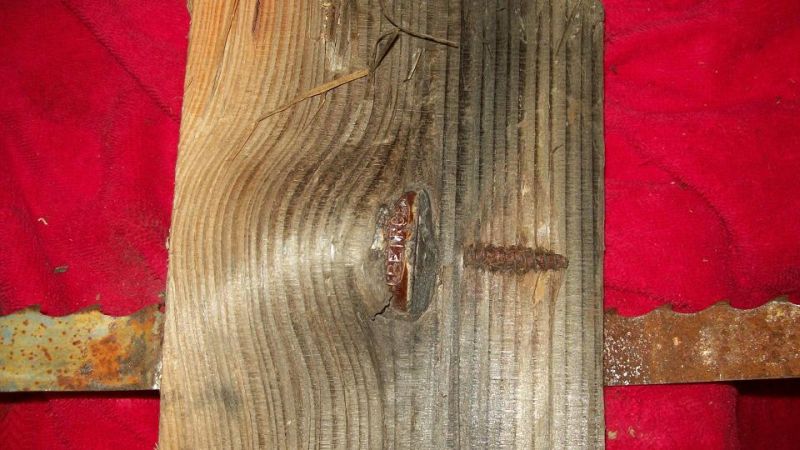
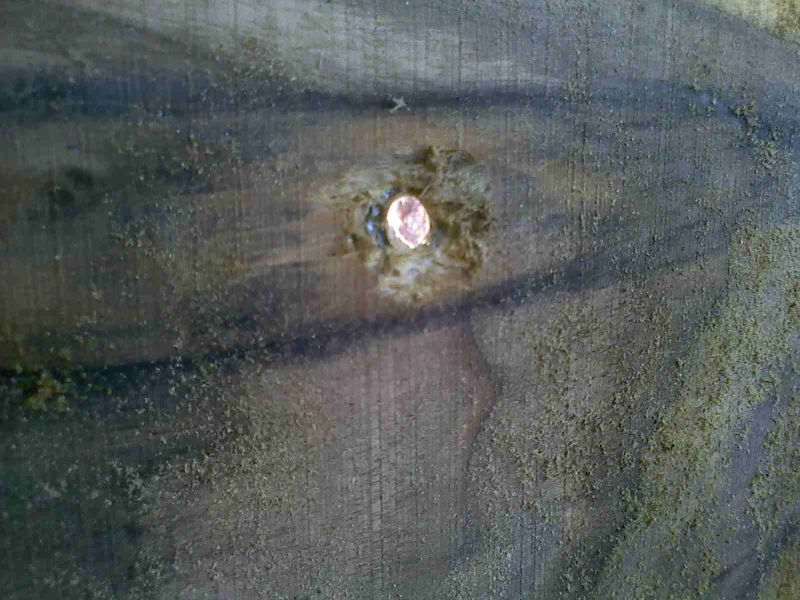
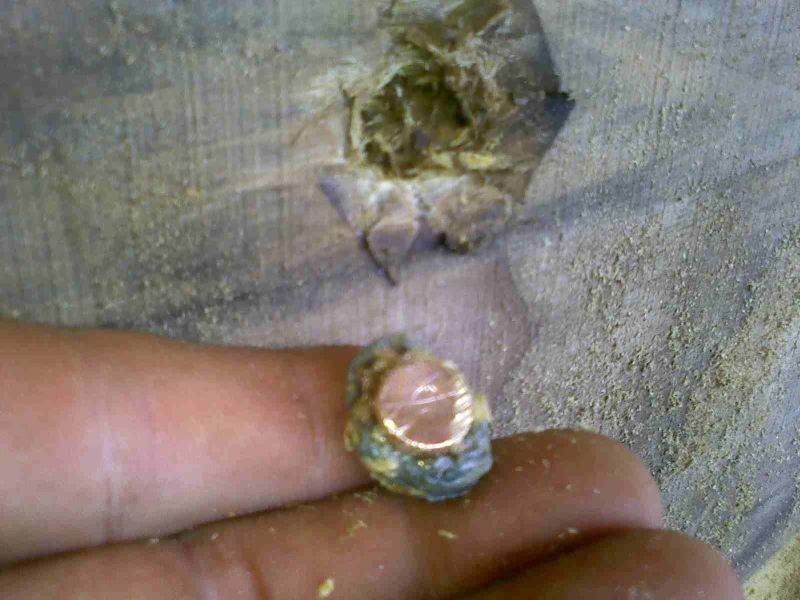
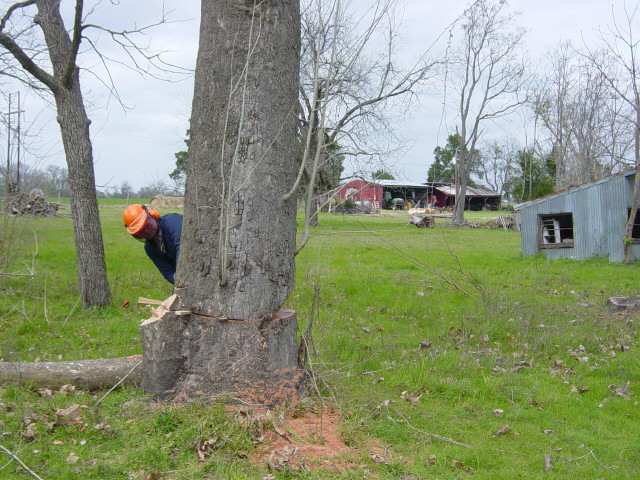
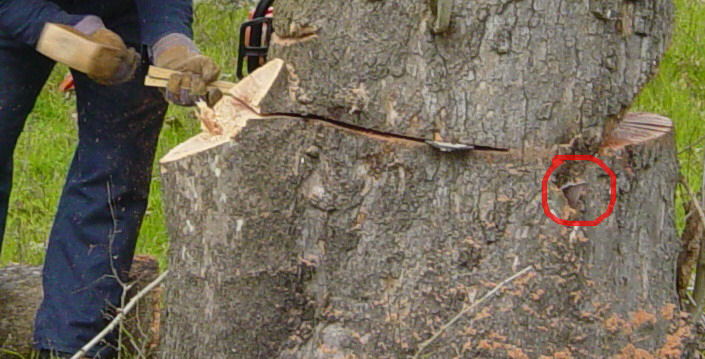
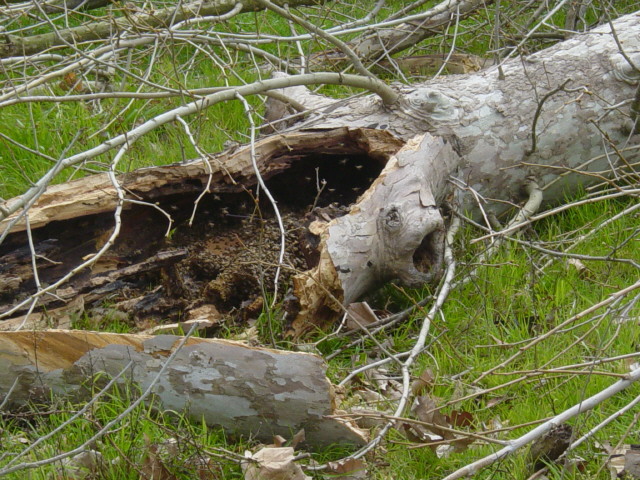
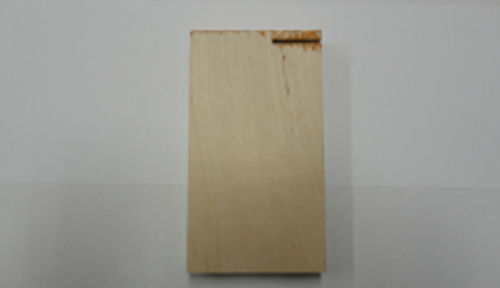
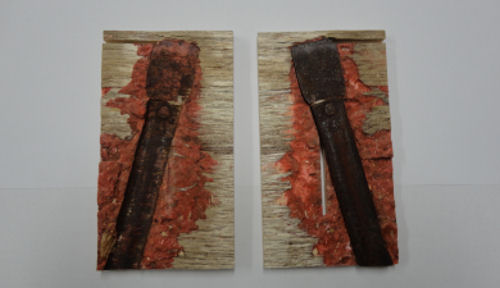

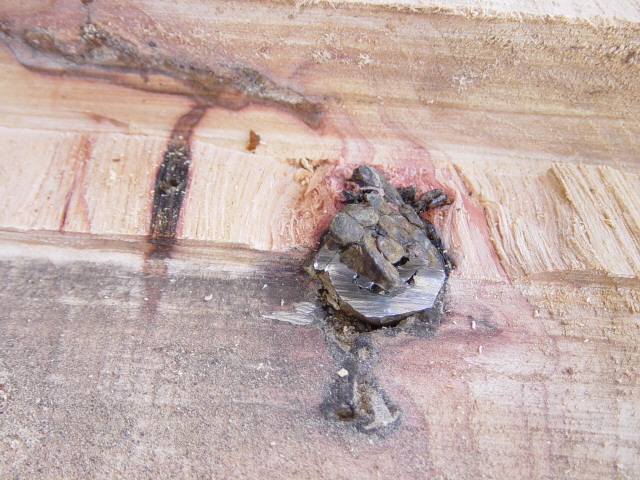
The butt log was 14 feet long and was maneuvered by a 640 Ford tractor to mill first thing in the morning. With fear and caution I loaded the log on the mill, the dogs looked like pups. I started milling the cant; all was well. The cant was 28 inches, clear, no runout. On the next cut the saw blade started diving. I pulled back and replaced the blade, and continued the cut and went about one foot further and hit another nail. I say nail because only four to five teeth show metal damage.
I put in a new blade, started another cut two inches below, and hit metal. As the morning passed, no blade would proceed more than a foot or so into the log. It was a bad day when I realized I was not going to saw the log away. I had nothing capable of removing the cant from the mill. Finding no way to slide the cant onto the loading arms I went at it with a chainsaw, promptly ruining the chains. It would seem that the log is full of nails and can't be milled. I was able to saw though the cant eight feet below the top leaving six foot of the broad and nail riddled base. The tractor did lift the six foot cant off and it is now a yard ornament. The top eight feet did not have as many nails and I was able to mill it off. I lost a day, milled very little lumber, and gained a conversation piece for the yard.
| Common Lumber Name | A | B | C |
| Hardwoods | |||
| Alder, Red | 9.9 | 19.2 | 2506 |
| Apple | 10.9 | 31.7 | 4132 |
| Ash, Black | 9.3 | 23.4 | 4132 |
| Ash, Green | 14.3 | 27.6 | 3590 |
| Aspen, Bigtooth | 10.3 | 18.7 | 2439 |
| Aspen, Quaking | 10.3 | 18.2 | 2373 |
| Basswood | 6.2 | 16.6 | 2174 |
| Beech, American | 8.9 | 29.1 | 3793 |
| Birch, Paper | 8.8 | 25.0 | 3260 |
| Birch, Sweet | 11.9 | 31.2 | 4065 |
| Birch, Yellow | 9.2 | 28.6 | 3723 |
| Buckeye | 8.9 | 17.2 | 2235 |
| Butternut | 11.3 | 18.7 | 2440 |
| Cherry | 13.8 | 24.4 | 3184 |
| Chesnut, American | 11.6 | 20.8 | 2708 |
| Cottonwood | 8.5 | 16.1 | 2102 |
| Dogwood | 6.8 | 33.3 | 4331 |
| Elm, American | 10.2 | 23.9 | 3116 |
| Elm, Rock | 12.2 | 29.6 | 3860 |
| Elm, slippery | 11.5 | 25.0 | 3251 |
| Hackberry | 11.8 | 25.5 | 3319 |
| Hickory, Bitternut (Pecan) | 14.7 | 31.2 | 4062 |
| Hickory (True) | |||
| Hickory, Mockernut | 9.1 | 33.3 | 4332 |
| Hickory, Pignut | 9.3 | 34.3 | 4332 |
| Hickory, Shagbark | 10.9 | 33.3 | 4333 |
| Hickory, Shellbark | 6.6 | 32.2 | 4195 |
| Holly, American | 8.3 | 26.0 | 3387 |
| Hophornbeam, Eastern | 7.9 | 32.8 | 4266 |
| Laurel, California | 15.1 | 26.5 | 3456 |
| Locust, Black | 21.2 | 34.3 | 4470 |
| Madrone, Pacific | 7.8 | 30.2 | 3925 |
| Maple (Soft) | |||
| Maple, Bigleaf | 12.8 | 22.9 | 2980 |
| Maple, Red | 13.1 | 25.5 | 3318 |
| Maple, Silver | 12.4 | 22.9 | 2981 |
| Maple (Hard) | |||
| Maple, Black | 12.3 | 27.0 | 3523 |
| Maple, Sugar | 12.3 | 29.1 | 3793 |
| Oak (Red) | |||
| Oak, Black | 11.7 | 29.1 | 3792 |
| Oak, California black | 16.4 | 26.5 | 3455 |
| Oak, Laurel | 6.3 | 29.1 | 3791 |
| Oak, Northern red | 13.6 | 29.1 | 3793 |
| Oak, Pin | 13.0 | 30.2 | 3928 |
| Oak, Scarlet | 13.2 | 31.2 | 4065 |
| Oak, Southern red | 9.6 | 27.0 | 3520 |
| Oak, Water | 10.4 | 29.1 | 3793 |
| Oak, Willow | 6.4 | 29.1 | 3790 |
| Oak (White) | |||
| Oak, Bur | 15.4 | 30.2 | 3928 |
| Oak, Chestnut | 10.1 | 29.6 | 3858 |
| Oak, Live | 17.5 | 41.6 | 5417 |
| Oak, Overcup | 10.7 | 29.6 | 3860 |
| Oak, Post | 11.0 | 31.2 | 4063 |
| Oak, Swamp chestnut | 10.7 | 31.2 | 4063 |
| Oak, White | 10.8 | 31.2 | 4062 |
| Persimmon | 7.0 | 33.3 | 4332 |
| Sweetgum | 8.9 | 23.9 | 3115 |
| Sycamore | 10.7 | 23.9 | 3115 |
| Tanoak | 9.0 | 30.2 | 3926 |
| Tupelo, Black | 10.4 | 23.9 | 3116 |
| Tupelo, Water | 12.4 | 23.9 | 3115 |
| Walnut | 13.4 | 26.5 | 3454 |
| Willow, Black | 8.6 | 18.7 | 2438 |
| Yellow-poplar | 10.6 | 20.8 | 2708 |
| Common Lumber Name | A | B | C |
| Softwoods | |||
| Baldcypress | 13.2 | 21.9 | 2844 |
| Cedar, Alaska | 14.4 | 21.9 | 2844 |
| Cedar, Atlantic white | 10.9 | 16.1 | 2100 |
| Cedar, eastern red | 16.4 | 22.9 | 2981 |
| Cedar, Incense | 13.1 | 18.2 | 2371 |
| Cedar, Northern white | 11.1 | 15.1 | 1964 |
| Cedar, Port-Orford | 12.6 | 20.2 | 2641 |
| Cedar, Western red | 12.2 | 16.1 | 2100 |
| Douglas-fir, Coast type | 12.3 | 23.4 | 3049 |
| Douglas-fir, Interior west | 13.2 | 23.9 | 3116 |
| Douglas-fir, Interior north | 14.0 | 23.4 | 3048 |
| Fir, Balsam | 9.9 | 17.2 | 2236 |
| Fir, California red | 10.6 | 18.7 | 2437 |
| Fir, Grand | 10.7 | 18.2 | 2371 |
| Fir, Noble | 10.1 | 19.2 | 2507 |
| Fir, Pacific silver | 10.4 | 20.8 | 2711 |
| Fir, Subalpine | 10.5 | 16.1 | 2101 |
| Fir, White | 12.2 | 19.2 | 2506 |
| Hemlock, Eastern | 12.6 | 19.8 | 2573 |
| Hemlock, Western | 11.5 | 21.8 | 2847 |
| Larch, Western | 11.3 | 25.0 | 3251 |
| Pine, Eastern white | 12.3 | 17.7 | 2303 |
| Pine, Lodgepole | 11.5 | 19.8 | 2576 |
| Pine, Ponderosa | 12.6 | 19.8 | 2573 |
| Pine, Red | 12.2 | 21.3 | 2777 |
| Southern yellow group | |||
| Pine, Loblolly | 12.9 | 24.4 | 3183 |
| Pine, Longleaf | 15.0 | 28.1 | 3658 |
| Pine, Shortleaf | 12.9 | 24.4 | 3183 |
| Pine, Sugar | 12.6 | 17.7 | 2302 |
| Pine, Western white | 10.0 | 18.2 | 2370 |
| Redwood, Old growth | 14.9 | 19.8 | 2573 |
| Redwood, Second growth | 13.2 | 17.7 | 2302 |
| Spruce, Black | 11.3 | 19.8 | 2575 |
| Spruce, Engelmann | 10.0 | 17.2 | 2234 |
| Spruce, Red | 10.6 | 19.2 | 2506 |
| Spruce, Sitka | 10.8 | 19.2 | 2506 |
| Tamarack | 12.0 | 25.5 | 3318 |